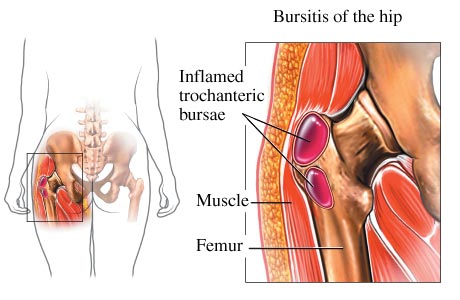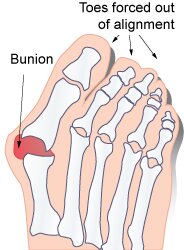Why Your Feet Hurt
It’s probably due to one of these ailments. Here’s how to treat them. For serious pain, see a podiatrist or a podiatric surgeon.

1. Plantar Fasciitis
Feels like: A sharp pain in your heel (or heels) that’s at its worst when you get out of bed.What causes it: Inflammation of the plantar fascia, a thick band of tissue that runs along the bottom of your foot from the heel to the toes. People with all arch types―high, medium, or low―can be prone to this type of irritation, says Carly Robbins, a podiatric surgeon in Columbus, Ohio. Wearing shoes with very flat or very high heels can worsen the problem. “If a shoe doesn’t support the arch, the fascia will be stretched, and that can cause inflammation,” says Robbins. And if your Achilles tendon often feels tight, it can exacerbate the issue.

Treatment strategies
- Wear structured shoes. Look for pairs that support the arches and enclose the heels. Avoid going barefoot or wearing ballet flats or flip-flops.
- Stretch your Achilles tendons in the morning. “The plantar fascia is in a relaxed position when you’re sleeping,” says Jacqueline Sutera, a podiatric surgeon in New York City. “Then it gets a jolt of tension when you put weight on it.” Before hopping out of bed, wrap a towel or a T-shirt around your feet and pull the toes back to stretch the tendons.
- Reduce swelling. Fill a plastic bottle with water, freeze it, and roll it under your foot for a few minutes to soothe the pain.
- Consider custom orthotics. A podiatrist can make inserts that are molded specifically for your feet, which will control their motion and decrease strain on the plantar fasciae when worn inside shoes.
2. Ingrown Toenail

What causes it: This often occurs when the nail edge grows sideways into the skin of the toe. The pressure on the nail jabs into the surrounding skin, causing discomfort. Wearing shoes that are too tight or too narrow can exacerbate the problem. Cutting toenails incorrectly can also be a culprit.
Treatment strategies
- Wear pointy-toed shoes infrequently. And if you’ll be walking a lot, carry them and wear shoes with roomy toe boxes until you reach your destination.
- Keep feet well moisturized. When the skin on your toes gets inflamed, a callus can develop, causing more pressure on the ingrown nail. Keeping skin soft helps alleviate this problem.
- Cut toenails straight across. And don’t file the corners down. If you get pedicures, be sure the technician follows these rules.
- See a podiatrist if you suspect infection. Signs include significant swelling and redness. “Don’t try any bathroom surgery,” says Robbins. “Digging around the nail and trying to cut out the ingrown part can lead to more irritation.”
3. Bursitis
Feels like: A bump, usually on the back of a heel.What causes it: “This condition can occur when you have a genetically enlarged heel bone,” says Marlene Reid, a podiatric surgeon in Naperville, Illinois. “It’s often called ‘pump bump’ because the bone can become irritated from wearing a shoe like a pump with a stiff back.” When the unforgiving shoe rubs against the bone, you can inflame the bursa, the protective sac of fluid in the tissue.


Treatment strategies
- Switch to shoes with open backs (or at least with more give) until the irritation subsides.
- Use a donut pad. Try Dr. Scholl’s Foam Ease Callus Cushions ($4.50 at drugstores). Place one over the bursa to alleviate pressure. At the end of the day, ice the area to soothe the inflammation.
- Consider seeing a doctor. If the problem causes chronic pain, a podiatric surgeon can remove the bursa and the enlarged part of the heel bone.
4. Stress fracture
Feels like: A tender area, often on the front part of the foot, at the second or third metatarsal (the metatarsals are the long bones in the midfoot).What causes it: Repetitive stress on a bone, like walking or running on hard surfaces, especially in shoes that aren’t designed to absorb shocks. “Every summer, I see fractures in women who walk the city sidewalks all day in flip-flops,” says Sutera. High heels can also make you more susceptible to stress fractures, because the heel’s tilt distributes your weight over your foot unevenly.

Treatment strategies
- See a doctor no matter what. A podiatrist will give you a surgical shoe to wear as you heal (it has a hard bottom that doesn’t allow the affected bones to bend) or advise you to wear some other kind of rigid shoes.
- Slow down. Stress fractures take four to eight weeks to heal. During that time, you’ll need to stop running and limit your walking to what’s absolutely necessary.
- Prevent recurrences. Maintain a healthy weight and wear supportive, well-cushioned shoes.
5. Bunions
Feel like: Sensitive, protruding bumps, typically at the heads of the big-toe joints.What causes them: Bunions are thought to be hereditary, and you can develop them if you have low arches or if you overpronate (your feet roll inward). “As the bump gets bigger, it’s actually your bone moving,” says Robbins. Wearing certain shoes―such as those with narrow, pointy toes and high heels―won’t cause bunions to form, but they can speed their progression.

Treatment strategies
- Choose the right shoes. Specifically, pick pairs with a wide toe box and a low heel.
- Try gel pads. Place them over the bunions to help cushion the areas and reduce pain.
- Consider surgery. If your bunions continue to get worse, become very painful, or begin to affect your feet’s mobility, a podiatric surgeon can realign the joints and shave off the protruding bones.
6. Neuroma
Feels like: A shooting pain in the ball of the foot.What causes it: Pressure on the nerve tissue in the underside of the foot, usually between two adjacent metatarsals. This pressure irritates the nerves, and the area swells. “Narrow, pointy shoes can put added pressure on an already irritated nerve,” says Robbins.

Treatment strategies
- Wear shoes with a wide toe box. And stick to those with low heels.
- Employ anti-inflammatories. Take ibuprofen, or if that’s not enough, see a podiatrist and ask about a cortisone injection, which should bring down the swelling of the nerve immediately.
- Consider surgery. For a stubborn neuroma that won’t go away with less invasive treatments, a doctor can use cryotreatment, a surgical technique in which a probe is inserted to eradicate the problem nerve.

No comments:
Post a Comment